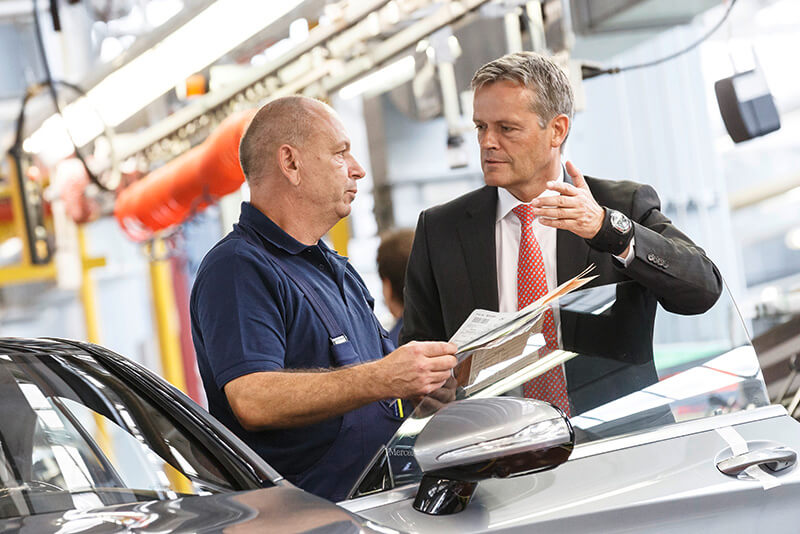 It may have taken Mercedes-Benz around 120 years to reach 1m cars per year, breaching the mark around the turn of the 21stcentury. However, the recent surge in growth of the brand has seen it rise by around 1m units in sales and production in just five years, with passenger car output at around 2.4m in 2017, helping it to regain the global luxury crown from BMW.
It may have taken Mercedes-Benz around 120 years to reach 1m cars per year, breaching the mark around the turn of the 21stcentury. However, the recent surge in growth of the brand has seen it rise by around 1m units in sales and production in just five years, with passenger car output at around 2.4m in 2017, helping it to regain the global luxury crown from BMW.
Such expansion can cause problems in the supply chain and strain plant capacity – something Markus Schäfer, member of the divisional board of Mercedes-Benz Cars for production and supply chain, does not deny. For logistics, the expansion has helped bring attention right to the top table where Schäfer sits in terms of cost and performance. “Logistics is becoming more and more important for us,” he said at a small roundtable meeting involving Automotive Logistics at the Geneva motor show recently.
Partly in response, the company has overhauled its supply chain management department, moving from a transport-focused organisation to a global end-to-end approach that integrates planning and capacity planning, purchasing and operations across inbound, in-plant and vehicle logistics. This includes input on vehicle programmes at the earliest stage of their development.
As well helping to manage growth, the supply chain plays a vital role in increasing flexibility in shifting production parts and products between the company’s 32 assembly and component plants, which Schäfer sees as the key to balancing its industrial network. Such changes in location could be because of shifting customer demands, regulations, currency changes or even in response to tariff or customs barriers – like Donald Trump’s plans for elevated duties on steel and aluminium, or fallout from the Nafta and Brexit negotiations.
This flexibility is set to become even more significant as Mercedes-Benz electrifies its model line-up. The carmaker has announced it will provide plug-in hybrid or full electric variants by 2022 for all its cars, covering more than 50 models over the next five years, including 10 electric models built across six plants in Germany, France, the US and China – among them the new EQ series. It is a big bet – one worth about €11 billion ($13.5 billion) in expanding vehicle assembly operations and building battery plants – but one Daimler is hedging by further developing its ‘full flex plant’ concept, which will see different model sizes, drive systems and powertrains move down the same assembly line.
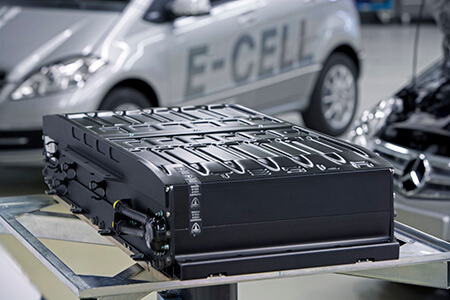
According to Schäfer, such flexibility was unthinkable just over a decade ago. But over the past few years, Mercedes-Benz has linked its front-wheel and rear-wheel drive plants to allow for quicker exchanges, and is now doing the same for SUV plants. For electric vehicles, Schäfer says it will be relatively easy to integrate them into existing plants as long as Mercedes-Benz’s production and logistics teams are involved in the design and development of such models right from the start.
“We work hand-in-hand with R&D colleagues from day one on the concept of a new family of cars to consider production flexibility, pickup points and geometry to achieve this flexibility in production,” he says.
Logistics also has an essential role to play as production and distribution use more digital technology. The carmaker’s plans for a new facility at its Sindelfingen plant, near Stuttgart, known as ‘Factory 56’, will bring together a host of digital pilots and know-how, from RFID to driverless transport systems, digital twin simulations and even the use of automated driving features for vehicle logistics handling.
Schäfer also envisions further links between customers and the supply chain, with the potential for customers to modify their orders and deliveries via smartphone.
Roundtable Q&A: Markus Schäfer
Mercedes-Benz has announced significant investments in electric vehicle and battery production. Is this the main driver of growth and change in your supply chain and production network?
There are currently two big trends overlapping. One is the growth that we continue to experience, which has run at around 10% year-on-year over the last few years. In response, we are expanding and adding new facilities worldwide, and that has also been a challenge. But we are also seeing a move from more conventional combustion engines to electric plug-in and battery electric vehicles, as well as – eventually – autonomous, robo-cars.
So growth and new technology are two big movements that we are trying to combine at the moment. Our answer is an intelligent network of production plants.
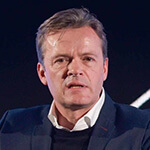 “Growth and new technology are two big movements that we are trying to combine at the moment. Our answer is an intelligent network of production plants.” - Markus Schäfer, Mercedes-Benz
“Growth and new technology are two big movements that we are trying to combine at the moment. Our answer is an intelligent network of production plants.” - Markus Schäfer, Mercedes-Benz
In what way is the connection of your network of plants different to before?
It is that we are more flexible and able to move product from one plant to another. We cannot predict with certainty what will happen globally in terms of protective trade measures, currency shifts, customer demands and preferences, or even in terms of the allocation of new models to plants in the future. Therefore, it is important that we can move product around the globe to fill plants to a maximum and make sure we meet customer demand.
Having this worldwide network is going to be key to us on the EV side, as it will be important that we can run a plant that builds cars with combustion engines, EVs and plug-in hybrids and thus be very flexible to customer demand.
Over the last five years, for example, we have created the concept of the ‘full-flex plant’, which is able to do just that: shift products around the globe to meet demand and fill capacity. This has helped improve our performance.
Are the tariff and customs threats in the US or from the fallout over Brexit impacting on your supply chain and production decisions?
Because our network is designed to be flexible for moving components and products, it helps us to react to things happening in the world, of which there are many. Things are happening in China in terms of trade barriers, or in South-East Asia with countries running customs duties of more than 100% for many years. India has high customs duties. Russia is changing its duty scheme, and there are currency developments. We can’t control this, but a flexible production system gives us the manoeuvrability we need. However, where we have to react, we will react.
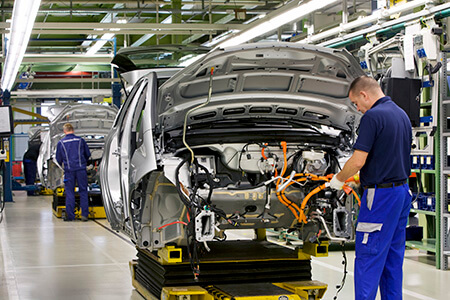 Schäfer says it will be relatively easy to integrate electric vehicles into existing plants if production and logistics teams are involved from the start
Schäfer says it will be relatively easy to integrate electric vehicles into existing plants if production and logistics teams are involved from the startIs the supply chain equally as flexible in responding and changing products as the plants?
The supply chain and our suppliers ultimately have to be as flexible as our plants, and it is something we need to work on whenever we award different components to suppliers. Whether we make door panels, carpets or seats, we have to look at the geometric and material considerations at the very beginning to ensure there is not much difference in what we are using [across models]. This enables suppliers to be more flexible, if we shift from one product to another. We also stick to the same design concepts for components that we buy from the supply base.
How important is logistics in this strategy?
Logistics is becoming more and more important for us because of several different elements. One is in controlling inventory, which a global company like ours has huge potential to reduce. There is also a lot of cost involved in transporting goods from supplier to plants, moving material within factories, and delivering the product to market.
This was the motivation for us to create our own organisation within operations that covers the end-to-end supply chain. This team is focused on reducing inventory, delivery times and costs. We organise the total supply chain ourselves, picking up every component from supplier facilities, and then designing the most optimal transport. So, for example, we use crossdocks to make sure we have full transport loads to reduce cost and CO2, and choose the right mode of transport.
Many of the digital processes that will be in use at your ‘Factory 56’ facility in Sindelfingen, such as driverless transport systems and RFID, already exist in some form at other plants. What will make this site unique?
We are combining all our knowledge and pilots in production technology into one greenfield factory, which will be copied at other plants. It is a holistic approach that starts with the creation and planning of the product in R&D in a digital simulation. That means that before we see hardware, we simulate test crashes, factory planning, layout and even the movement of workers and the material flow. This makes us faster and more flexible, reduces investment and ensures we have the right quality of processes.
Do you see this as a step towards more modular production concepts?
We will move away from conveyor lines that are fixed in the ground. At that point, we will have AGVs not only moving the materials as today, but also moving cars in production to different stations. We will also be able to change not only the material flow, but also the layout and configuration of a plant in as little as a weekend.
[mpu_ad]Workers and machines will also interact digitally with each other, whether through tablets, screens, wearables or smart glasses, to assist in picking, fitting and meeting assembly requirements. For example, even for actions as simple as connecting electric wires, there will be digital indications of which wires to plug in where, and whether it was done correctly or not. The material and robots will interact digitally with each other.
The data we collect and analyse will be just as valuable, including in real time from machines to help improve the uptime of the factory and move toward zero faults.
Your Factory 56 plan involves potential use of the ‘Mercedes-Me’ platform to let the customer check the progress of their car in production. How significant will this customer interaction become in the supply chain?
In the reference model of Factory 56, we want to connect the customer to the factory using our Mercedes-Me digital platform, which we are expanding. One feature is already that the customer can check the delivery progress of his product after he has ordered it. The next step could be that the customer could modify the product.
It is not simple to connect the customer to the factory, supply chain and engineering. But we imagine that customers could, for example, send a JPEG file of whatever they might want, such as a name or a signature to be printed in the car. We could then communicate that to the plant, directly to a stitching machine or laser that would produce the image on the seat or [elsewhere in the] cockpit.
A further step would be for the customer to order different components and make changes at a very late point before production. If you combine this with 3D printing, we could become even more flexible and responsive to customer desires right up to the latest possible point. This gives us good ideas and opportunities for business in the future.
Are you already using 3D printing?Yes, we are one of the largest 3D printers, printing more than 100,000 large prototype components using around six different methods, including plastics, metals and different technologies. We produce several thousand prototypes per year, printing most of these parts ourselves. From this, we have gained a lot of knowledge that we might extend to new business areas in the future.
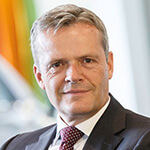 “Logistics is becoming more and more important for us because of several different elements. One is in controlling inventory, which a global company like ours has huge potential to reduce. There is also a lot of cost involved in transporting goods from supplier to plants, moving material within factories, and delivering the product to market.” - Markus Schäfer, Mercedes-Benz
“Logistics is becoming more and more important for us because of several different elements. One is in controlling inventory, which a global company like ours has huge potential to reduce. There is also a lot of cost involved in transporting goods from supplier to plants, moving material within factories, and delivering the product to market.” - Markus Schäfer, Mercedes-Benz
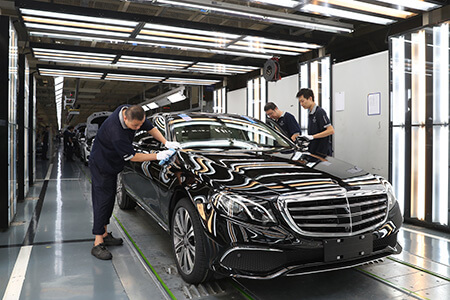 Mercedes-Benz’s joint venture in China with BAIC produces cars such as the C-class and E-class (pictured), as well as the GLA and GLC SUVs
Mercedes-Benz’s joint venture in China with BAIC produces cars such as the C-class and E-class (pictured), as well as the GLA and GLC SUVsFlexible plants and supply chains are important to Mercedes-Benz’s growth strategy.
In recent years, the carmaker has added production of the GLC SUV to its contract manufacturing partner Valmet, in Finland, where it moves down the same line as the compact A-class. In China, its joint venture with BAIC also includes sedans and estate cars like the C-class and E-class, produced along with the GLA and GLC SUVs. The company is also building a new plant in Russia close to Moscow.
Fitting plug-in hybrid and electric battery versions of models into existing plants will be a significant efficiency. However, the increase in output together with the shift towards electrification also requires significant new investment, capacity and supply chain links.
In the US, for example, the carmaker is investing $1 billion at its Tuscaloosa, Alabama, plant to add production of an electric SUV. Factory 56, in Sindelfingen, will build the new S-class and the first electric vehicle of the EQ brand, and eventually autonomous vehicles (features of which the company plans to use in vehicle logistics at the plant). In Hungary, meanwhile, Mercedes-Benz is adding the new A-class to its plant, which already produces nearly 200,000 cars a year, and construction of a second plant is underway. The carmaker is also investing 11.9 billion yuan ($1.87 billion) in its joint venture in China to expand capacity in Beijing, including taking over an existing BAIC facility.
While electric vehicles will become part of the production mix at its plants, they also require an expansion of Mercedes-Benz’s powertrain network, the facilities for which cannot so easily switch between petrol, diesel and electric systems. The company has already announced investments of more than €1 billion for five battery plants: two in Kamenz, in eastern Germany, of which one is already operational and running on three shifts; another close to Stuttgart; one near Tuscaloosa, in Alabama; and one in Shenyang, China.
“We will be building a range of batteries from plug-in hybrid to 48 volt electric lithium-ion batteries,” says Schäfer.
The carmaker’s current investment will total several gigawatts, he adds – which will doubtless send a very significant charge throughout the whole Mercedes-Benz supply chain.


























![Global[1]](https://d3n5uof8vony13.cloudfront.net/Pictures/web/a/d/s/global1_726550.svgz)












